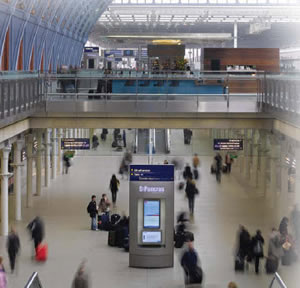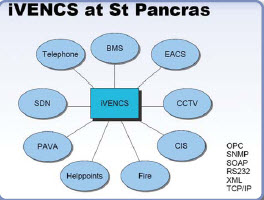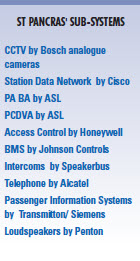The Full Picture
Converting the old St Pancras station into an iconic international terminus has been a huge success. This modern, complex and multi-level environment is controlled by an integrated station management system, as Jane Fenwick explains.
Visiting the refurbished and transformed St PanCras station it is hard not to marvel at the restored George Gilbert Scott roof that contrasts with the sleek Eurostar trains arriving alongside the longest champagne bar in the world. The £800m refurbishment of the station opened in 2007 and it’s planned to cope with about 40m passengers a year, so meeting all expectations.
|
|
Not only has St Pancras won the RIBA London & English Heritage Award for a Building in a Historic Context, it also scooped the Most Innovative International Retail & Leisure Concept of the Year Award for the way more than 60 shops and 15 bars and restaurants have been sited in the undercroft below the Grade 1 listed station – formerly a Victorian beer store.
Behind the scenes this iconic, complex and multi-level international station is managed and controlled from a single centralised control room. Unique in the world of station control systems, St Pancras has the capability for control room operators to utilise a 3D graphical user interface to navigate around a dynamic virtual model of the station to locate and interact with CCTV cameras, help points and other equipment.
|
|
Developed for the St Pancras station refurbishment by UK-based Application Solutions (ASL) , the iVencs Station Control System provides real- time monitoring of 16 sub-systems such as Public Address / Voice Alarm, CCTV, help points, BMS, passenger information and security systems whilst also monitoring the station’s integrated data network. It can track and record alarms and events, and integrate multiple inputs from these sub systems to allow automated intelligent responses to the changing stimuli throughout the building.
Of the 16 sub-systems integrated at St Pancras, only two systems are supplied by ASL — the rest are from other suppliers (see panel) — but all have been integrated under one control. Usually control rooms have separate displays for each of the various systems being monitored. For example, the safety and security systems including CCTV cameras, access control points and fire alarms each reporting either to separate screens on the operator’s desk or a bank of wall panels. What the iVencs system does is to integrate the control and monitoring functions into a single operator station. The 3D user interface is groundbreaking in the simplicity with which all this complex information is presented to operators, enabling rapid and direct action even in high-pressure situations.
|
|
It is a truly distributed system and the same software can run on a basic PC in a small building or servers spanning a site, a railway line or a global network of facilities. Multiple redundancy is built into the software and if there is a hardware failure then other hot-standby hardware seamlessly continues the system operation without noticeable interruption to operators. ASL’s expertise was originally with PA/VA (public address/voice alarm) systems and it delivered the PA/VA system for the new St Pancras. Developing the iVencs system for St Pancras has involved building a comprehensive toolset using technologies that could be easily understood from first principles by anyone using or maintaining the system.
The major bid for the station management system contract was won against more complex and established systems by using an open architecture approach to allow seamless integration of the 16 sub systems and 7,500 assets across the station complex which would not traditionally be possible if relying solely on existing legacy building protocols. ASL provided a turn-key solution, delivering the integration, building the toolset, supplying hardware and then implementing and commissioning the finished system in time for opening.
The impressive 3D ‘front end’ looks expensive but, as ASL’s Richard Lack, explained it represents just 3 per cent of the total investment. The engineers took the 2D plans from the architects, and within a few weeks had produced a 3D version showing cabling infrastructure and the location and information for each of the thousands of assets (eg CCTV cameras, loudspeakers, information display panels, break-glass, induction loops etc — see above).
ASL’s iVencs station management system is based on the use of increasingly prevalent open systems and is a truly open source product. All development tools are open source, and the protocols and middleware are also based around open source technology. As Lack explained, ASL’s experience in life-critical PA/VA technology meant that they had already developed the detailed hardware integration skills for large-scale IP / analogue infrastructure projects requiring challenging audio and video management using open protocols.
The value of this 3D technology has been felt as early as the design stage of the St Pancras station project. For example, with 3D visualisation, designing the CCTV system was made easier. Consultants and commissioning engineers could accurately position the cameras in the 3D model and see the coverage of each unit. In this way both the number of units that needed to be installed and system effectiveness in operation could be more accurately calculated, reducing costs in the commissioning stage.
An important requirement for operating the station management system was to enable the operators to navigate through the system with a minimum number of ‘clicks’. In fact most actions can be undertaken with just three clicks, making it easy to learn and operate.
Controlling access to the station complex is important particularly in such a high- profile public environment. Vehicles delivering to the station, shops and bars access a special area through barriers operated from the control room. The system automatically alerts the control room when delivery vehicles enter the loading area, checking the licence plates against the vehicles expected and only releasing the barrier when security checks have been completed. Individuals can be tracked through the station with the ‘best four’ video feeds being automatically calculated and displayed on a video wall in the control room when an operator clicks on the suspect’s location in the 3D model.
The electronic passenger information displays are also controlled by the iVencs system and can be used to give directions to passengers from the control room as well as advice on train departures.
The iVencs system can identify faults in the various subsystems and the location of faulty units. This means that maintenance engineers clicking on an alarm are instantly directed to the position of faulty equipment in the station. When faults occur, a couple of mouse clicks display the location of the failed equipment. Failures in any of the 12 rack rooms around the station or in the miles of cabling can also be easily located making it quicker for engineers to find and rectify faults. Most of the subsystem providers at St Pancras can log in remotely via a secure VPN (Virtual Private Network) and do anything an on-site engineer can do except swap out faulty equipment. iVencs features a ‘publish and subscribe model’ that only tells contractors about the information relevant to them, and gives them access to explore only permitted parts of the system which are relevant to them. There is a complete audit trail on every touch point in the system, including the identity of the operator and the credentials of the engineers for each event. This 3D user interface is a ground-breaking advance for systems that manage complex public buildings such as stations, airports and shopping centres, and potentially other large, complex property portfolios. A virtual world has been created for the control room operators to navigate in 3D, around corners and up escalators to view the status of live objects that represent real-life equipment and associated information from the asset database.


